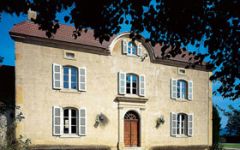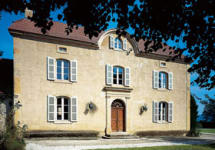Chateau Peyros Madiran Tannat-Cabernet Franc 2013



Product Details
Your Rating
Somm Note
Winemaker Notes
Peyros has a dark, intense ruby color with garnet-red reflects. With an intense nose of red berries with notes of raspberries, spices, and vanilla. On the palate, the wine is round and rich with a finish of mellowed tannins. Well structured wine with a good length on the palate. Pairs well with roasted red meats, poultry, duck confit and refined cheeses.
Other Vintages
2016-
Wine
Enthusiast
-
Wine
Enthusiast
-
Wine
Enthusiast


The vines are cultivated using sustainable growing techniques. The organic contribution is natural, exclusively made up of manure from a herd of 300 sheep that amble around the vineyard from October to April.
The fermentation room was built in the early 80s under the guidance of Emile Peynaud, oenologist and one of the founders of traceability. In 2000, the fermentation room was equipped with a micro-oxygenation system. Malolactic fermentation in barrels is practiced on the third of the wines (those housed in new barrels) to give body and soften the tannins. Chateau Peyros Castle has an impressive record and is mentioned in all the best guides.

With hundreds of red grape varieties to choose from, winemakers have the freedom to create a virtually endless assortment of blended red wines. In many European regions, strict laws are in place determining the set of varieties that may be used, but in the New World, experimentation is permitted and encouraged resulting in a wide variety of red wine styles. Blending can be utilized to enhance balance or create complexity, lending different layers of flavors and aromas. For example, a red wine blend variety that creates a fruity and full-bodied wine would do well combined with one that is naturally high in acidity and tannins. Sometimes small amounts of a particular variety are added to boost color or aromatics. Blending can take place before or after fermentation, with the latter, more popular option giving more control to the winemaker over the final qualities of the wine.
How to Serve Red Wine
A common piece of advice is to serve red wine at “room temperature,” but this suggestion is imprecise. After all, room temperature in January is likely to be quite different than in August, even considering the possible effect of central heating and air conditioning systems. The proper temperature to aim for is 55° F to 60° F for lighter-bodied reds and 60° F to 65° F for fuller-bodied wines.
How Long Does Red Wine Last?
Once opened and re-corked, a bottle stored in a cool, dark environment (like your fridge) will stay fresh and nicely drinkable for a day or two. There are products available that can extend that period by a couple of days. As for unopened bottles, optimal storage means keeping them on their sides in a moderately humid environment at about 57° F. Red wines stored in this manner will stay good – and possibly improve – for anywhere from one year to multiple decades. Assessing how long to hold on to a bottle is a complicated science. If you are planning long-term storage of your reds, seek the advice of a wine professional.

Offering the perfect balance of quality and value, Southwest, France is a recognized appellation that encompasses all wine regions in France’s southwestern corner (except for Bordeaux and Cognac, which merit their very own). Two of the more famous subregions here are Cahors, known for its Malbec, and Madiran, home of the robust Tannat grape. Bordeaux Blends are also popular red wines of the Southwest; Petit Manseng is the regions’s star autochthonous white variety.
